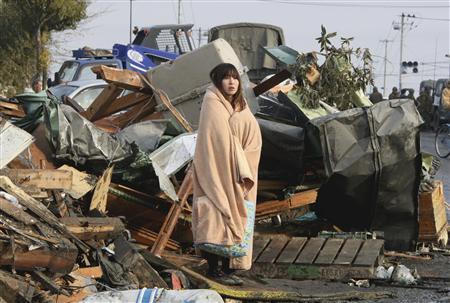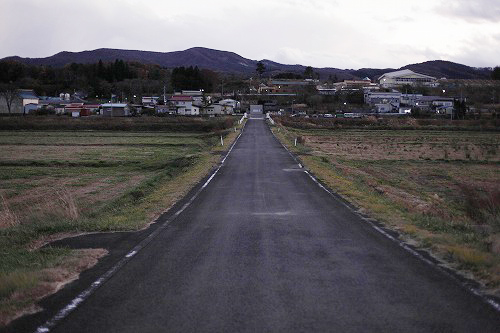Posts Tagged ‘cesium’
Three months after Fukushima – hot particles, rotten fish and studied whitewash

A coastal community in Natori, Miyagi Prefecture is flooded by tsunami waters after a massive earthquake off Japan's east coast on March 11. Photo: Mainichi
How far will the culpable go to deny the dangers of atomic energy, even when confronted with the evidence day after day for three months? Far enough to shock us over and again, every single one of those days. There has been melt-through – not just meltdown – at Fukushima, widespread contamination by radiation of water, the ifrst medical evidence of the impacts of airborne radiation, and still the nuclear industry and its political partners deals out lies. They do this even when the humanitarian crisis of the Tohoku earthquake and tsunami continues.
A variety of news reports have said that the Tokyo metropolitan government has decided to take radiation readings at 100 sites around the city and to measure at ground level and near ground level. The city was previously taking readings only from a 19-meter high monitoring station in Tokyo. The action was prompted after citizens began finding higher readings that those released by the city government.
ABC news has reported: “Highly toxic radioactive strontium has been found in groundwater near the crippled Fukushima nuclear plant. It is the first time the substance has been detected in groundwater near the plant’s No. 1 and No. 2 reactors. The operator of the Fukushima plant has also confirmed strontium up to 240 times the legal limit has been found in seawater near the facility. Strontium tends to accumulate in bones and can cause bone cancer and leukaemia. “Last week, soil samples from outside the Fukushima plant also revealed concentrations of strontium.” Fukushima city officials say they will distribute radiation readers to 30,000 children between the ages of four and 15. News reports vary as to when the children will receive the badges.
[See the Japan nuclear emergency page for an archive of news reports, analyses, videos, gtaphics and links on the Fukushima nuclear emergency, and the shorter posting on the nuclear plant crisis.]

A woman looks at the damage caused by a tsunami and an earthquake in Ishimaki City, Miyagi Prefecture, after the magnitude 8.9 earthquake struck the area March 13, 2011. Photo: Reuters/Yomiuri Shimbun
The Japanese government has prepared a report on the accident at the Fukushima I nuclear power station (NPS) of Tokyo Electric Power Co., Inc. (TEPCO) and submitted it to the International Atomic Energy Agency (IAEA) on June 7. According to the Denki Shimbun the findings will be reported at the IAEA ministerial conference due to start on June 20. The 750-page report outlines several facts and observations including the developments of the accident, Japan’s nuclear safety regulatory framework, radiation exposure situations and lessons learned from the accident, and states at the conclusion that “Japan has recognized that a fundamental revision of its nuclear safety preparedness and response is inevitable.” As part of plans for the fundamental revision, the report declares that the Japanese government will separate the Nuclear and Industrial Safety Agency (NISA) from the Ministry of Economy, Trade and Industry (METI) and start reviewing the administration of nuclear safety regulations.
The report consists of 13 themes. In the introduction, it points out that “the situation has become extremely severe” in dealing with the Fukushima I accident, due to the circumstances where the accident had to be dealt with in parallel with reconstruction work following the disaster caused by the great earthquake and tsunami. The report also includes an apology in relation to the nuclear accident, stating, “Japan sincerely regrets causing anxiety for people all over the world about the release of radioactive materials.”
In ‘Silent Crisis in Tohoku’, Ex-SKF and Tokyo Brown Tabby have said that with the rainy and typhoon seasons approaching and temperature rising, there are serious concerns that infectious diseases might spread in the earthquake/tsunami-struck areas. From what? Rotten fish. When the earthquake and tsunami destroyed the refrigerated storage and processing facilities for fish, the fish started to rot.

Japanese medical personnel check a child for radiation exposure in Fukushima City. Photo: Guardian/EPA
“Conditions are already bad for the residents and evacuees in Tohoku: lots of dust rising from debris and rubble; awful smell of wet and mouldy piles of wooden debris and tatami mats; awful smell of sludge; and now awful smell of rotten fish (mostly from many devastated seafood processing plants) and smell of bird faeces feeding on those rotten fish; and finally the threat of mosquitoes as summer approaches, as well as rats and cockroaches.”
“They have been spraying insecticides and deodorizers in vain, since huge amounts of rotten seafood products are still under piles and piles of rubble. Unless all the debris and rubble, rotten fish and all that are completely removed, there is no stopping the hideous smells and mass breeding of those pests that could transmit diseases.”
On June 12, on a night news program called “Mr. Sunday” (Fuji TV), it was reported that more than 20,000 temporary houses have been built, but only about 45% of them are occupied, because once evacuees move to these temporary houses, all the food supply would be cut off and they would have to pay for utilities even though many of them are still unemployed. In one city in Miyagi Prefecture, the number of drunk driving has doubled, since alcoholism has increased due to mental depression.
Last week, Japan’s government announced a shake-up of the country’s nuclear regulatory agencies that would separate NISA from the Ministry of Economy, Trade and Industry (METI), which is also responsible for promoting the nuclear industry. The World Socialist Web Site has said that these cosmetic changes will do little to alter the incestuous relationship between Japan’s regulators and energy giants like TEPCO. There is a well-worn path trodden by senior NISA and METI officials from the state bureaucracy into corporate boardrooms. NISA’s response to the latest revelation that eight TEPCO employees had received radiation doses above the legal limit was typical. The agency described the situation as “extremely regrettable” and issued a formal warning to TEPCO—in other words, a slap on the wrist, as it has done on previous occasions.

Anti-nuclear demonstrators march in Cologne, western Germany Saturday March 26, 2011 to protest against nuclear power. Poster in front reads: Fukushima warns: Pull the Plug on all Nuclear Power Plants. White banner behind reads : 'Solidarity with the people in Japan'. Some 200,000 people turned out in Germany's largest cities on Saturday to protest against the use of nuclear power in the wake of Japan's Fukushima reactor disaster, police and organizers said.
The cover-up is not confined to Japan, however. On June 1, the International Atomic Energy Agency (IAEA) issued an interim report on the Fukushima disaster that listed the most obvious deficiencies in TEPCO’s safety measures but had nothing but praise for the official response. It said the government, regulatory agencies and the company had been “extremely open” in sharing information. TEPCO management at the site had been “exemplary” under arduous conditions. The government’s protection of the public had been “impressive and extremely well organised”.
The purpose of this IAEA whitewash was elaborated quite openly by deputy director general Denis Flory, who told the media: “There is a need to rebuild the confidence of the public towards their government, when their governments have decided to use nuclear energy.” Like Japan’s regulatory authorities, the IAEA is intimately bound up with the nuclear industry, which is expanding internationally and is tasked with regulating energy giants that are driven by profit, not the welfare of ordinary people.
In the US, physician Janette Sherman MD and epidemiologist Joseph Mangano published an essay that talks about a 35% spike in infant mortality in northwest cities that occurred after the Fukushima meltdown, and may well be the result of fallout from the stricken nuclear plant. The eight cities included in the report are San Jose, Berkeley, San Francisco, Sacramento, Santa Cruz, Portland, Seattle, and Boise, and the time frame of the report included the ten weeks immediately following the disaster.
“There is and should be concern about younger people being exposed, and the Japanese government will be giving out radiation monitors to children,” Dr MV Ramana, a physicist with the Programme on Science and Global Security at Princeton University who specialises in issues of nuclear safety, told Al Jazeera. Dr Ramana explained that he believes the primary radiation threat continues to be mostly for residents living within 50km of the plant, but added: “There are going to be areas outside of the Japanese government’s 20km mandatory evacuation zone where radiation is higher. So that could mean evacuation zones in those areas as well.”
Arnold Gundersen, who has 39 years of nuclear power engineering experience, managing and coordinating projects at 70 nuclear power plants around the US, points out that far more radiation has been released than has been reported. “They recalculated the amount of radiation released, but the news is really not talking about this,” he said. “The new calculations show that within the first week of the accident, they released 2.3 times as much radiation as they thought they released in the first 80 days.” According to Gundersen, the exposed reactors and fuel cores are continuing to release microns of caesium, strontium, and plutonium isotopes. These are referred to as “hot particles”.




